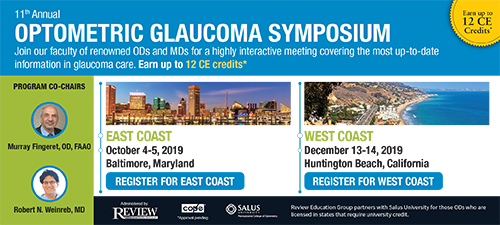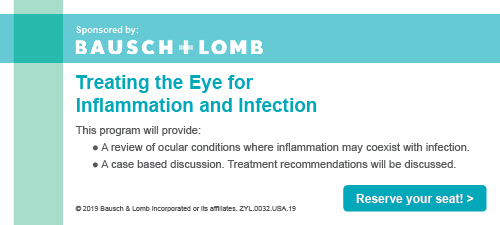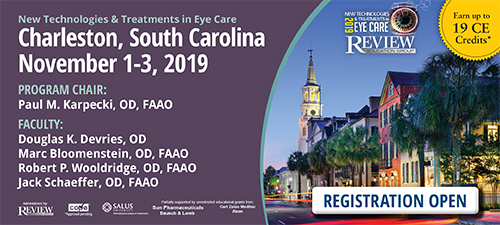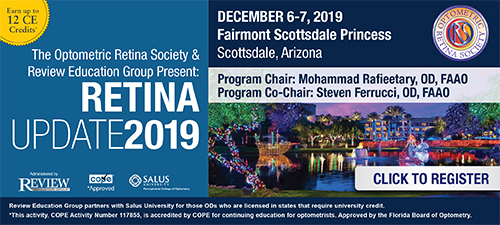
A
weekly e-journal by Art Epstein, OD, FAAO
Off the Cuff: Not a Dry Eye in the House
Over the past few years, managing dry eye has gone from warm compresses and massage to an abundance of procedures, some powerful enough to change patients’ lives. Perhaps the biggest challenge the clinician faces is deciding which procedure to use for which patient. Gland obstruction is a key driver of MGD and the resultant tear dysfunction. It down-regulates meibum production and leads to stagnation, inflammation and, ultimately, gland loss. Gland clearance through expression is among the most important and effective treatments for MGD. We added Lipiflow (TearScience) within weeks of opening our practice, and for many patients it has been a core treatment. I long ago lost count of how many procedures we’ve performed, but I can instantly recall many patients who experienced life-changing improvements in their dry eye. With the addition of Sight Sciences’ TearCare, the expression side of procedural treatment is well covered. Late last year, based on a growing body of scientific and clinical evidence, I took a leap of faith and invested in a Lumenis M22 intense pulsed light (IPL) device. Figuring out where IPL belonged in the practice was daunting at first. My initial criteria included evidence of ocular rosacea such as telangiectatic vessels with associated inflammation of the lid margins. My experience with IPL for ocular rosacea and MGD has been phenomenal. However, I believe its mechanism is misunderstood. Little of the energy it delivers to the glands is in the form of heat. As a result, I’ve found no reason for or benefit from expressing glands after treatment. IPL has a known photo-modulatory effect, and I am increasingly convinced it also has photo-regenerative properties. Experience suggests it stimulates gland function. I have also observed dramatic improvement in lipid quality after IPL.The learning curve for IPL is steep, and I still rely on Lipiflow and TearCare for patients who primarily have obstruction. In the presence of inflammation, and especially ocular rosacea, IPL is my first choice. Clearly there is overlap between the two approaches and for some patients, the most effective treatment is a combination of the two. As we follow our IPL patients, I suspect I will have a lot more to say in the coming months.
|
|||||
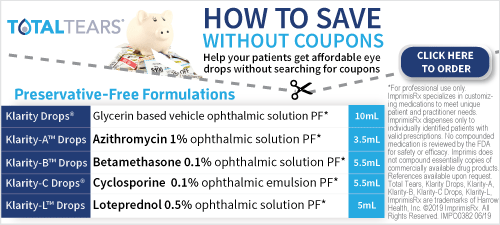 |
||
| A Case of Uveitis-Hyphema-Glaucoma Syndrome Due to Ex-Press Glaucoma Filtration Device Implantation | ||||
This case reports a 69-year-old patient who developed uveitis-glaucoma-hyphema syndrome after an uneventful Ex-Press mini shunt (Alcon) surgery for advanced primary open-angle glaucoma and discusses management options and clinical implications. Uveitis-glaucoma-hyphema syndrome is a rare but serious complication usually after cataract surgery. It is often described in anterior chamber intraocular lenses, sulcus lenses, as well as malpositioned or subluxed lenses resulting in chafing of the lens-iris interface. Clinical manifestations include increased intraocular pressure, anterior chamber inflammation and recurrent hyphema. A 69-year-old African American man developed uveitis-glaucoma-hyphema syndrome eight years after uneventful implantation of a P-50 Ex-Press mini shunt. Slit-lamp examination demonstrated persistent inflammation without evidence of iris atrophy nor IOL dislocation; however, gonioscopy demonstrated localized iris atrophy under the shunt with surrounding iris billowing and a layered hyphema.
A localized laser iridoplasty around the shunt was performed, leading to resolution of the uveitis and hyphema. No other complications occurred during follow-up. Given the increasing acceptance of glaucoma procedures involving implants, uveitis-glaucoma-hyphema syndrome may become more prevalent as new sources of intraocular devices may cause potential complications. Laser iridoplasty provides a minimally invasive approach to treating a localized source of chafing and reduce further surgical intervention. |
||||
SOURCE: Hou A, Hasbrook M, Crandall D. A case of uveitis-hyphema-glaucoma syndrome due to ex-press glaucoma filtration device implantation. J Glaucoma. July 12, 201. [Epub ahead of print]. |
||||
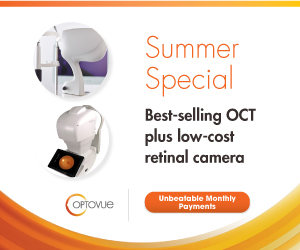 |
||
| Two-year Analysis Of Changes In The Optic Nerve And Retina Following Anti-VEGF Treatments In Diabetic Macular Edema Patients | ||||
Patients with clinically significant diabetic macular edema (DME) requiring anti-VEGF injections underwent pre-injection baseline, six, 12 and 24 month follow-up tests to evaluate long-term structural and functional changes that happen to the optic nerve and retina following Lucentis (ranibizumab, Genentech) injections in DME patients. The tests performed were optical coherence tomography (OCT), best-corrected visual acuity (BCVA) and visual fields (VF). Widefield fluorescein angiogram (IVFA) was performed to monitor the progression of diabetic ischemia.
A total of 30 patients requiring anti-VEGF injections and 21 control patients not requiring anti-VEGF injections were enrolled in the study. From baseline, the average macular thickness significantly decreased over the 24-month time period. Mean perfused ratio significantly increased at six, 12 and 24 months. Cup volume and vertical cup-to-disk ratio significantly increased over the study period. This was verified by masked independent grading of patient optic nerve stereo photographs by glaucoma specialists. BCVA significantly improved over the study period. VFs showed a non-significant trend of deteriorating peripheral vision at 12 and 24 months. Clinically, anti-VEGF therapy appears to affect the optic nerve by increasing cup volume and increasing vertical cup-to-disk ratio over time. The results provide a cautionary note to monitor both the retina and optic nerve status in patients undergoing frequent injections. |
||||
SOURCE: Filek R, Hooper P, Sheidow TG, et al. Two-year analysis of changes in the optic nerve and retina following anti-VEGF treatments in diabetic macular edema patients. Clin Ophthalmol. 2019;13:1087-96. |
||||
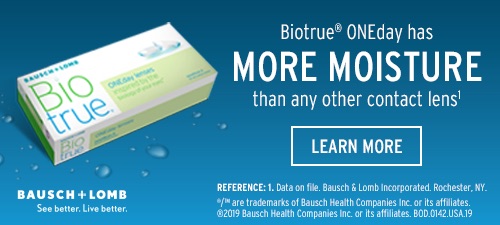 |
||
| Outcome Of Peripheral Iridotomy In Subjects With Uveitis | ||||
Peripheral iridotomy (PI) may be required in subjects with uveitis to manage iris bombe, seclusio pupillae and primary angle-closure glaucoma. The aim of this study was to identify risk factors for failure of both laser and surgical PIs in patients with uveitis and determine survival durations. This was a retrospective study of subjects with a history of uveitis undergoing YAG laser or surgical PI at Auckland District Health Board over an 11-year period. PI failure was defined as loss of patency or recurrence of iris bombe. A mixed-effects shared frailty model was constructed with PI nested within eyes nested within patients, to examine time to failure. 131 PIs were performed in 52 eyes of 39 subjects during the study period (111 YAG PIs and 20 surgical PIs). Median age at time of PI was 46.6 years and 60.5% of subjects were female. HLAB27-positive uveitis was the most common diagnosis (25.6% of subjects). Median survival time was 70 days for YAG PI and 11.0 years for surgical PI. On multivariate analysis, younger age at time of PI (HR 0.933) and iris bombe (HR 2.180) were associated with risk of failure. Surgical PI was associated with a lower risk of failure (HR 0.151) compared with YAG PI. Glaucoma developed in 19 eyes (36.5%), of which 13 required glaucoma surgery. Surgical PI had longer survival than YAG PI, and should be considered in subjects presenting with iris bombe and in young subjects with uveitis. |
||||
SOURCE: Betts TD, Sims JL, Bennett SL, Niederer RL. Outcome of peripheral iridotomy in subjects with uveitis. Br J Ophthalmol. July 9, 2019. [Epub ahead of print]. |
||||
 |
||
| News & Notes | |||||||||||||||
| Clerio Vision Acquires Manufacturer of Extreme H2O Contact Lenses Clerio Vision acquired Hydrogel Vision Corp, bringing together HVC’s expertise in the manufacturing and distribution of high-performance contact lenses with Clerio’s innovative product pipeline. HVC, founded in 2002, is best known for its Extreme H2O product line that personalizes the contact lens wearing experience. Clerio was founded in 2014 to commercialize breakthrough femtosecond laser research at the University of Rochester. The company’s technology enables the laser writing of unique patterns into contact lenses that optimize visual acuity. Clerio’s multifocal contact lens product is currently in clinical development and is expected to be on the market in the upcoming 18 months. Learn more.
|
|||||||||||||||
| Coloursmith Closes Financing to Develop Lens-enhancing Filters Coloursmith Labs raised more than $600,000 in pre-seed funding to advance the development of its optical filter platform and address challenging vision problems. The company’s early-stage product pipeline includes an optical filter to enhance color vision for the color blind and an optical filter to protect eyes from harmful blue light. Read more.
|
|||||||||||||||
| Alcon Dailies Colors CLs Offer New Way to Try on Eye Color Alcon recently debuted Dailies Colors contact lenses that combine eye color enhancements with a daily disposable contact lens. The line features four colors— Mystic Blue, Mystic Gray, Mystic Hazel and Mystic Green. The contact lenses combine an eye-defining outer ring to make eyes appear bigger and brighter, with Alcon’s 3-in-1 Color Technology. Read more. |
|||||||||||||||
|
|||||||||||||||
|
|||||||||||||||
|
Optometric Physician™ (OP) newsletter is owned and published by Dr. Arthur Epstein. It is distributed by the Review Group, a Division of Jobson Medical Information LLC (JMI), 11 Campus Boulevard, Newtown Square, PA 19073. HOW TO ADVERTISE |



